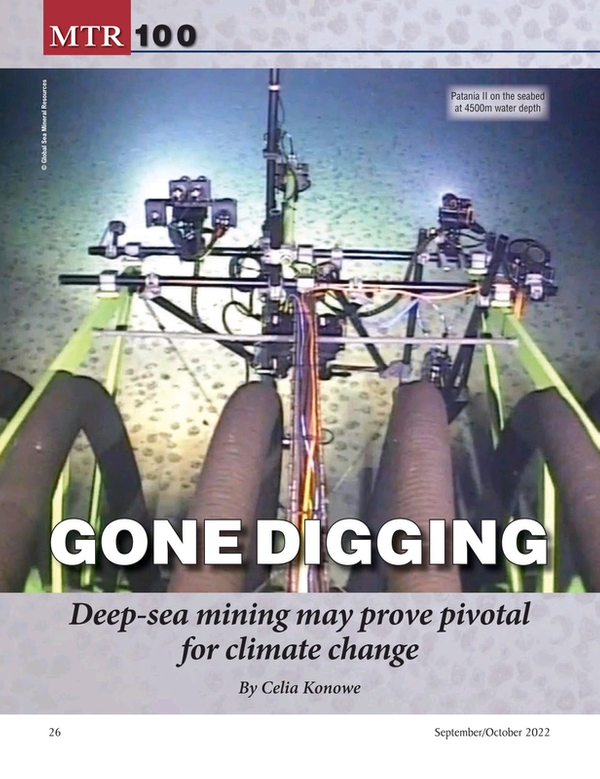
MTR100: Deep-sea Mining May Prove Pivotal in the Climate Change Discussion
During the past few years, much of the world has turned its eye towards adopting more sustainable practices and transitioning to net-zero and even carbon-zero emissions. Recent examples range from double-digit year-on-year electric vehicle (EV) sales percentage increases driven by individual consumer behavior to government pledges at the national, state and local level to lower emissions during the next three decades. Companies and industries have begun flocking towards this transition, aware of the opportunity to become leaders among their peers and fearful of becoming an outlier through relative inaction. This can be seen most clearly in aviation, whose biennial Farnborough International Airshow in July was dominated by discussions surrounding hurdles to a production ramp up of sustainable aviation fuels and the even longer-term pursuits of electric and hydrogen propulsion.
With a greener world comes the need for significant technological advancement, and more technology means more materials. As natural resources for EVs, solar panels, batteries and countless other important products begin to wane on land, key stakeholders have begun to look below the waters for minerals and rare earth elements (REE).
Deep-sea mining (DSM) arguably has become one of today’s most controversial marine activities. There is no denying that any human activity that requires taking resources from the earth is likely to cause damage—climate change and many of the environmental issues faced can be traced back to the Industrial Revolution and centuries of human exploitation. Early volleys in the deep-sea debate begins have included many scientists and governments agreeing that it’s premature to begin mining; too little is known about the seabed and its ecosystems, and the long-term impacts of mining are impossible to determine at this point. On September 8, French Polynesia became the most recent territory to call for a ban on DSM, calling out their “cousins of the Pacific”—Kiribati, Nauru and the Cook Islands—for pushing forward with mining despite only having explored about 5% of the seabed. “If we have to examine what’s on the ocean floor, it should be solely for the acquisition of knowledge, not for exploitation purposes,” said Minister for Marine Resources Heremoana Maamaatuaiahutapu in a television interview.
French Polynesia is not alone with numerous groups worldwide, like the Deep Sea Conservation Coalition (DSCC), also fighting for a moratorium. However, this is only one side of the battle. On the other are nations like Nauru, who started the countdown to DSM in June 2021 by giving the International Seabed Authority (ISA) two years to finalize regulations on industry activity. The ISA was established under the 1982 United Nations Convention on the Law of the Sea and has been developing a mining code since 2014. Many DSM stakeholders, like Nauru, feel that the ISA has had enough time to assess risk, and that the potential gain from deep sea minerals and REE is more important. With only a year left on Nauru’s ticking clock, DSM stakeholders face a big question whether environmental damage is worth the risk and how to minimize impact should the industry move forward.
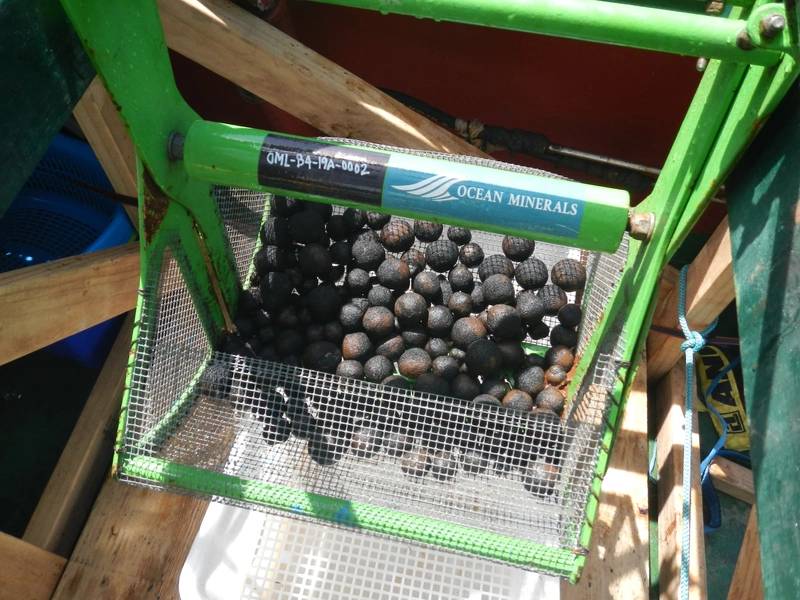 The results of a successful deployment of the free fall grab. Nodules. © Moana Minerals Ltd / Ocean Minerals LLC
The results of a successful deployment of the free fall grab. Nodules. © Moana Minerals Ltd / Ocean Minerals LLC
A nod to nodulesScientists have been exploring the effects of DSM on the environment and testing the least impactful techniques long before Nauru’s announcement. Much of the research and technology at the forefront of the industry focuses on polymetallic nodules, which is one of three DSM techniques. These nodules are potato-sized and multi-metal, found largely in the Clarion-Clipperton Zone (CCZ) in the Pacific Ocean (any mining interests in this area are managed by the ISA). They consist of manganese, nickel, cobalt and copper, and it’s estimated that in the CCZ alone, there is 1.2 times more manganese, 1.8 times more nickel, and 3.4 times more cobalt than in all known land reserves combined. “The multi-metal nature of the nodules means that a polymetallic nodule area is, in effect, two or three land-based mines in one, which means there is the potential to significantly reduce waste and CO2 emissions per ton of metal mined and minimize a number of other negative environmental and social effects associated with obtaining metals from our planet, such as deforestation and relocation of people,” explained Dr. Kris Van Nijen, managing director of Global Sea Mineral Resources (GSR). Polymetallic nodules are promising in their broad makeup and versatility—and despite lying almost five kilometers below the surface, there are few obstructions to collecting them, he explained. “There are no forests that need removing, no people who need relocating and no local power stations or transport infrastructure that needs building.”
The Cook Islands, alongside Nauru, have also begun to prepare for large scale DSM by collaborating with partners to explore the abundance of nodules in their exclusive economic zone (EEZ). Moana Minerals Limited is a company based on the Islands that focuses on nodule collection for the clean energy transition and exploring the EEZ for evidence-driven decisions. “This is all in line with our plan to work cooperatively with the Cook Islanders to ensure maximum local benefit is derived,” CEO Hans Smit said. “This is done through the use of local industry and businesses, employment of Cook Islanders and training programs to advance and grow the local workforce.” As part of their commitment to the Islands, Moana Minerals has embarked on a three-year exploration to understand ecosystem health by identifying the impacts of its mining systems so that its engineers can develop mitigation techniques. The nodules play a crucial role for achieving a happier, healthier future, Smit argued. “Without these metals the world will struggle to achieve the goals set for transitioning to alternate energies and to address climate change. These nodules are a resource that can be accessed without serious harm and certainly without destroying our oceans as some would like us to believe.”
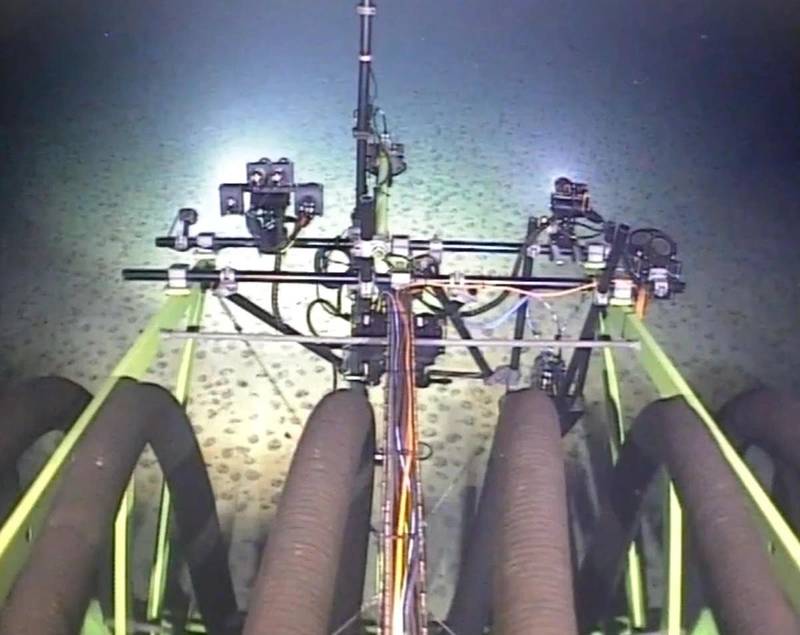 Patania II on the seabed at 4500m water depth © Global Sea Mineral Resources
Patania II on the seabed at 4500m water depth © Global Sea Mineral Resources
Quarry-some impacts
Nonetheless, human interference almost always poses an environmental risk. DSCC estimated that throughout a 30-year mining license period, each nodule-collecting operation would strip 8,000-9,000 square kilometers of seabed, leading to the possible extinction of species. In the second technique, when mining for cobalt-rich ferromanganese crusts, the outer layer of seamounts is stripped, destroying sea sponge and coral. The third type of DSM, which focuses on hydrothermal vents, would devastate these fragile and largely unknown ecosystems. Despite these risks, the industry has gained too much momentum, and scientists have been looking for ways to make the unavoidable as harmless as possible.
Dr. Daniel Jones, associate head of the Ocean BioGeosciences Group at the National Oceanography Center, has set out to better understand how ecosystems will respond to and recover from mining disturbance through a project called the Seabed Mining And Resilience To EXperimental impact, or SMARTEX. The collaboration will leverage analysis, modeling and vessels and marine robotic systems from the UK Natural Environment Research Council. SMARTEX’s work is unique in that its scope spans multiple decades. “I discovered information about the mining tests done in the late 1970s and had the idea of reinvestigating these so we could understand recovery processes over a reasonably long timescale of four decades,” Jones explained. “This would enable us to provide better evidence on the long-term impact of mining.”
The team is currently preparing for the first of their two expeditions to the CCZ, leaving in February 2023 from Costa Rica. Their work will be supported by a robust lineup of equipment, ranging from acoustic mapping to oceanographic moorings. Two key pieces of tech include their remotely operated vehicle (ROV), ISIS, and their autonomous underwater vehicle (AUV), Autosub 5. “The ROV will enable us to obtain amazing high-resolution images of the seafloor and the marine life inhabiting it. It will also allow us to collect specimens of some of the unusual animals, collect samples precisely in disturbed areas and enable us to do experiments on the seafloor,” Jones said. The AUV will gather seafloor images to quantity the density and distribution of marine life. Multibeam bathymetry and side-scan sonar will be used to make detailed maps, and the addition of a Robotic Cartridge Sampling Instrument will allow for evidence of life to be collected through DNA sampling.
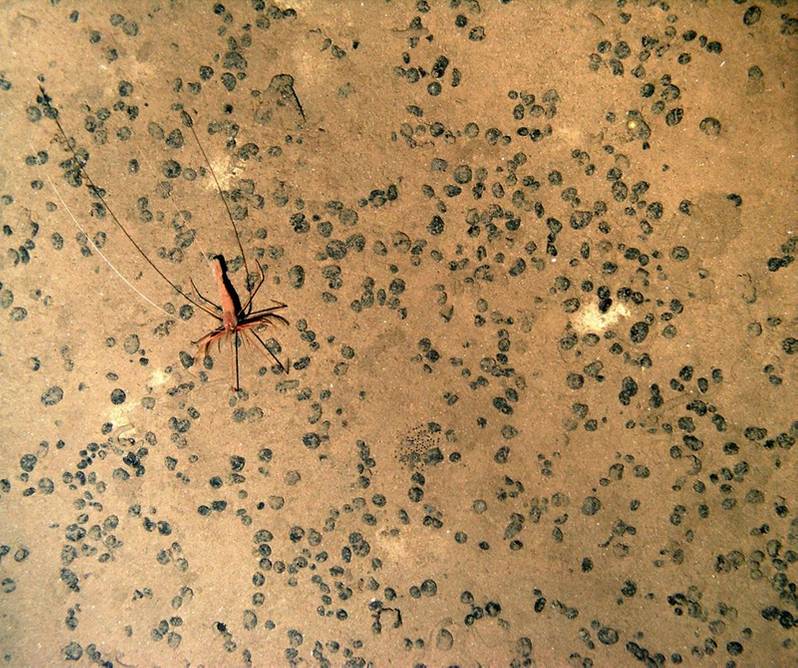 This shows a typical seabed photograph at the Clarion-Clipperton Zone at around 4500 m depth. We will be gathering many more photographs like this in SMARTEX. © National Oceanography Centre. www.noc.ac.uk
This shows a typical seabed photograph at the Clarion-Clipperton Zone at around 4500 m depth. We will be gathering many more photographs like this in SMARTEX. © National Oceanography Centre. www.noc.ac.uk
Sedimental value
Another risk of DSM is sediment plume. There are two types of plumes that occur during nodule mining—first, the collection vehicle skims the seabed, stirring up sediment and picking up nodules to send to a surface vessel above. The second plume is created as the surface vessel returns unwanted sediment and water from nodule collection back to the ocean. The disruption of sediment can impact filter feeders and species that use echolocation or bioluminescence to communicate and navigate. Dr. Thomas Peacock, a mechanical engineering professor and Director of MIT’s Environmental Dynamics Laboratory, has been collaborating on a project to monitor and track sediment plume from the mining process. “The goal,” he explained in video about the research, “is to understand if a sediment plume is released from a surface mining vessel, how far and in what concentration will that sediment travel. We can use that information to then determine how that will impact the ocean biology.” By tracking actual sediment plumes created by DSM in the Pacific, Peacock hopes to determine if the second plume can be returned in the mid-water column or closer to the seafloor, and how this may impact ecosystem processes and organism function.
Dr. ir. Rudy Helmons, assistant professor for offshore and dredging engineering at Delft University of Technology, and adjunct associate professor for deep-sea mining at Norwegian University of Science and Technology, is experimenting with the nodule collection process, as well. In a previous EU H2020 project, Blue Nodules, the collection technology was proven as effective, with a hydraulic or mechanical nodule collector skimming the seafloor, separating nodule from sediment, and discharging excess water and sediment behind the vessel. In Helmons’ current project, Blue Harvesting, he’s adapting this technology to have minimal environmental disturbance by reducing water and sediment intake. The lab has also investigated optimal discharge conditions to minimize plume dispersion and in the upcoming months, will test a new design of the hydraulic nodule collector.
The new design uses the Coanda principle, Helmons explained. “If you blow a fast flow along a curved object, it tends to follow the curvature of the object rather than moving straight ahead. A side effect is that while the flow remains attached to a curved object, it entrains more fluid to be able to do so. In our new design, we replaced part of the water that it would entrain by recirculating water that goes into the collector. That way, we are able to reduce the total amount of clean water that will enter the system by more than 50%.”
In terms of environmental impact, Helmons acknowledges that the mining industry can never be sustainable; these resources don’t grow or regrow—at least, not on human timescales. “I would explain that mining can be done in a responsible way, by being aware of its potential impact and its consequences. You should only mine for those materials that are really necessary to help society to progress, not just for monetary gains. That said, there will always remain an uncertainty on the long-term impact.”
“We do not yet know how what threshold values can be used to determine what environmental pressure is acceptable—what dosage is harmful? And a more challenging question is, how much harm will be acceptable to society or humankind as a whole?” Helmons posed. “We are limited to what extent we are able to predict the exact impact caused by a mining operation before doing it.”
GSR’s Patania II vessel shares a similar use of the Coanda effect to collect polymetallic nodules. Beginning in 2017, GSR trialed and developed different components of its nodule collector, fully testing Patania II for the first time in the CCZ in 2021. The collector head is unique in that it never touches the seafloor. “As the collector moves across the seabed, it uses jet water pumps to lift nodules into a collection drum. The collector head is a precision-engineered device that has been designed to collect nodules while minimizing disturbance of the surrounding sediment,” the company explained in a press release.
key part of GSR’s work, Van Nijen pointed out, is in situ component testing to not only validate the technology, but also assess environmental effects and ways to reduce them. “Since 2018, GSR has been collaborating with the European JPI Oceans research project, Mining Impact. Scientists from 28 European institutes have also joined efforts with the German exploration contract holder, BGR, to independently monitor the Patania II technology trials to help understand the environmental effects of collecting mineral resources from the seafloor.” While most of the data from trials are still under analysis, Van Nijen was able to share some updates from Patania II’s 15 dives and 107 hours of seabed operations. The AUVs proved to be crucial monitoring tools to document seafloor imagery, topography and sediment turbidity. Sediment plume predictions were correct in that most of the cloud would travel south-south-east and by examining the concentration of sediment at different altitudes, most stayed at low altitude, between the seabed and five meters. “The blanketing on the seafloor, created by the sediment plume, was also studied using the AUV,” he added. “Sedimentation was observed up to 1.5 to 2 kilometers away from the trial site towards the south. Past this distance, nodules are again clearly visible, which indicates that the sediment blanketing and most of the total mass of the resuspended material is settling quickly and near the mining area.”
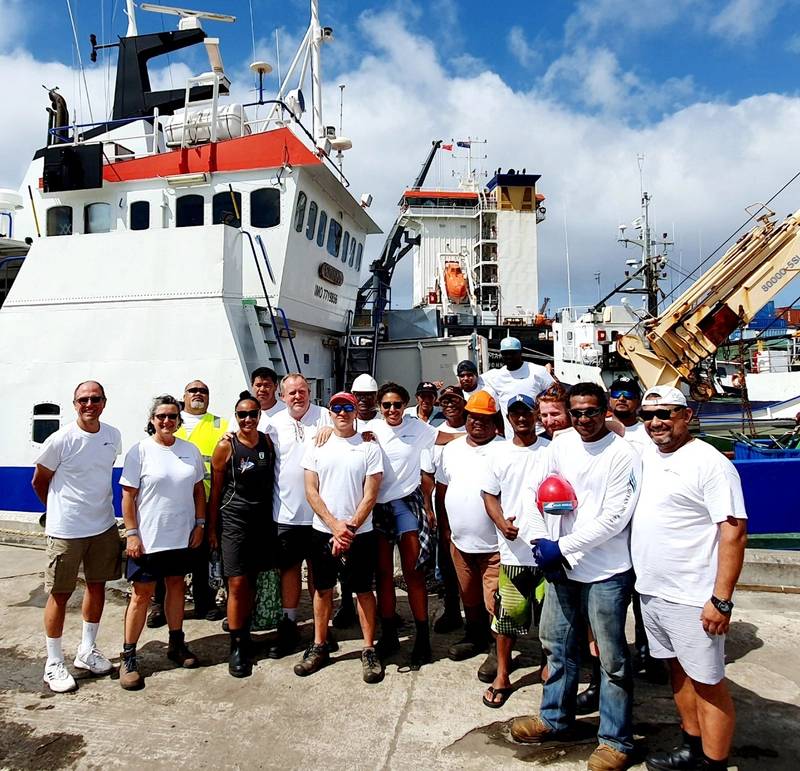 Departure of our first campaign using a local Cook Islands vessel with local crew and team members in support of our small team. © Moana Minerals Ltd / Ocean Minerals LLC
Departure of our first campaign using a local Cook Islands vessel with local crew and team members in support of our small team. © Moana Minerals Ltd / Ocean Minerals LLC
Mission possible?
The challenge of sustainable DSM may be daunting, but one that is being addressed by companies determined to find a balance between the two ends of the spectrum. Some, like Impossible Mining (IM), strive to tackle multiple industry issues in one fell swoop. IM was founded in response to three key problems within DSM, explained Renee Grogan, chief sustainability office and vice president of external relations. The first is that the available supply of critical metals needed for a full-scale transition to a green economy is short of the demand. The second is that some companies and governments are consenting to deep-ocean dredging technology, as opposed to less invasive techniques. Thirdly, traditional mineral processing is environmentally damaging in its use of hazardous reagents (like arsenic and cyanide), high electricity demand as well as creation of tailing dams, which are toxic waste ponds.
IM’s robotic collection system is like others that hover above the seafloor, minimizing interference with sediment and ecosystems. However, the company plans to use AUVs with artificial intelligence (AI), remote sensing and precision manipulators to harvest nodules individually. “The AI system will identify nodules that are host to observable life such as corals and sponges, and avoid contacting those nodules, leaving untouched both the nodules, as well as the organisms living on them,” Grogan explained. This system is currently in its proof-of-concept phase, with the shallow-water prototype being deployed later in 2022, followed by a deep-ocean prototype in 2023. IM hopes to reach full-scale production by the end of 2024.
Its bio-extraction process offers a one-of-a-kind technique, as well. The processing technology will extract minerals from the nodules using naturally occurring bacteria to dissolve the rock into solution, eliminating the use of toxic chemicals and tailings, and lowering the energy footprint. This process is in the same phase as the robotics, with all technology currently lab based. “We have plans to construct a pilot plant facility in 2023, to develop the necessary infrastructure required with scaling of the microbial processes and integration of the bio extraction into other parts of the mineral processing chain, such as crushing and grinding (at the front end), and metal separation (at the back end),” Grogan shared.
Seabed battle lines
The DSM industry’s controversy is far from over, even if the ISA issues a set of regulations before Nauru’s deadline. For some, this is a wakeup call that how humans treat the planet needs to change and that DSM presents too high of a risk to critical and fragile ecosystems scientists have only begun to understand. For others, this warning signals the urgency to move forwards with DSM to retrieve the materials necessary for a societal shift to green energy, regardless of potential environmental impacts. The emerging common ground can be characterized by the realization that the state of the earth is too dire to pause or postpone the transition to clean energy. In turn, the DSM industry will be expected to continuously assess and minimize environmental impacts through diligent research and technological advancement.
“We, collectively, need to do a better job with respect to thinking about the planet holistically and make choices about how to obtain resources with least harm to the environment and to the planet’s inhabitants in their entirety,” Van Nijen said. “Land and sea cannot be considered in isolation from each other. We face a whole-planet problem that needs a whole-planet solution, and the deep sea should be part of the discussion.”
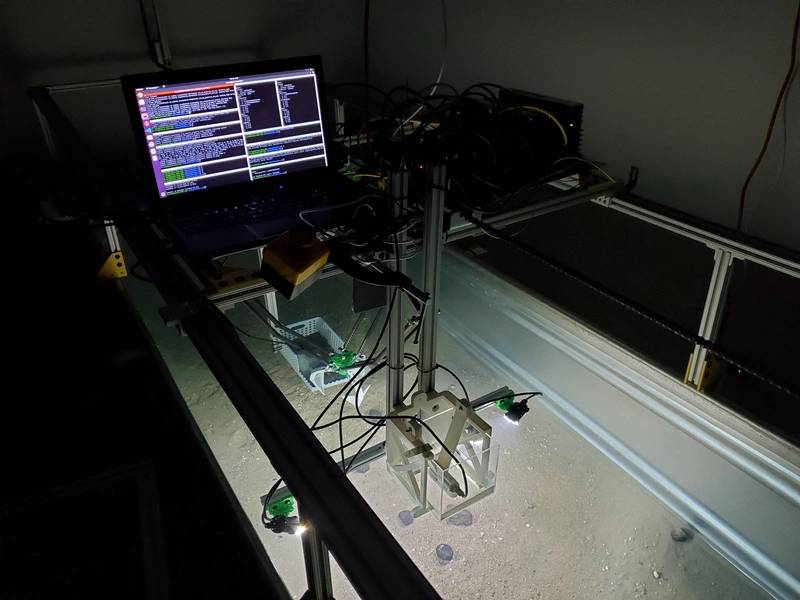 Bioextraction team working © Impossible Mining
Bioextraction team working © Impossible Mining
Read MTR100: Deep-sea Mining May Prove Pivotal in the Climate Change Discussion in Pdf, Flash or Html5 edition of September 2022 Marine Technology

